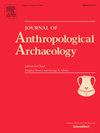Who is keen about jades? Evidence for socioeconomic differences between early Neolithic households at Chahai in Northeast China
IF 2.2
1区 社会学
Q1 ANTHROPOLOGY
引用次数: 0
Abstract
The rarity, color, hardness, and durability of jades provided them with special social, symbolic, and utilitarian value in many Neolithic communities. However, the process through which jade was transformed into objects of value in early communities and its role in household economy remains poorly understood. Therefore, this study examined these questions using household artifact data from an early Neolithic village in Northeastern China. The relationship between proxies for jade consumption and differences in various aspects of daily life, including domestic ritual, household scale, and economic production, was examined using household artifact assemblage analysis. The results indicated that some small households may have accumulated more jades than large households. Some of these households pursued jades holding ritual and religious significance, whereas others obtained durable jade tools. This initial consumption pattern may have been associated with different risk-buffering strategies stimulated by a limited household scale. The integrated evidence from Chahai offers an intriguing illustration of the potential origins of jade consumption within the matrices of households and their underlying socioeconomic dynamics. Furthermore, this may help explain the origins of jade consumption in Neolithic Northeastern China and other early complex societies.
谁喜欢玉器?中国东北察海地区新石器时代早期家庭社会经济差异的证据
在新石器时代的许多社会中,玉器的稀有、颜色、硬度和耐用性使它们具有特殊的社会、象征和实用价值。然而,玉在早期社会转变为有价值物品的过程及其在家庭经济中的作用仍然知之甚少。因此,本研究使用来自中国东北一个新石器时代早期村庄的家用人工制品数据来检验这些问题。利用家庭器物组合分析,考察了玉石消费与日常生活各方面差异之间的关系,包括家庭仪式、家庭规模和经济生产。结果表明,一些小户可能比大户积累了更多的玉石。其中一些家庭追求具有仪式和宗教意义的玉器,而另一些家庭则获得耐用的玉器工具。这种最初的消费模式可能与有限的家庭规模刺激的不同风险缓冲策略有关。来自Chahai的综合证据提供了一个有趣的例子,说明了家庭矩阵中玉石消费的潜在起源及其潜在的社会经济动态。此外,这可能有助于解释新石器时代中国东北和其他早期复杂社会中玉石消费的起源。
本文章由计算机程序翻译,如有差异,请以英文原文为准。
求助全文
约1分钟内获得全文
求助全文
来源期刊

Journal of Anthropological Archaeology
Multiple-
CiteScore
4.00
自引率
11.10%
发文量
64
期刊介绍:
An innovative, international publication, the Journal of Anthropological Archaeology is devoted to the development of theory and, in a broad sense, methodology for the systematic and rigorous understanding of the organization, operation, and evolution of human societies. The discipline served by the journal is characterized by its goals and approach, not by geographical or temporal bounds. The data utilized or treated range from the earliest archaeological evidence for the emergence of human culture to historically documented societies and the contemporary observations of the ethnographer, ethnoarchaeologist, sociologist, or geographer. These subjects appear in the journal as examples of cultural organization, operation, and evolution, not as specific historical phenomena.
 求助内容:
求助内容: 应助结果提醒方式:
应助结果提醒方式:


